AHM2009:PNL
PNL Roadmap Project
Overview
- What problem does the pipeline solve?
Most tractography methods (Deterministic/Principal Diffusion Direction) estimate fibers by tracing the maximum direction of diffusion. A limitation of this approach is that, in practice, several factors introduce uncertainty in the tracking procedure, including, noise, splitting and crossing fibers, head motion and image artifacts. Stochastic tractography attempts to quantify the uncertainty associated with estimated fibers, by using a propagation model based on stochastics and regularization, which allows paths originating at one point to branch and return a probability distribution of possible paths. Based on probability functions, using a sequential importance sampling technique (Bjornemo et al., 2002), one can generate thousands of fibers starting in the same point by sequentially drawing random step directions. This gives a very rich model of the fiber distribution, as contrasted with single fibers produced by conventional tractography methods. Moreover, from a large number of sampled paths, probability maps can be generated, providing better estimates of connectivity between several anatomical locations.
- Who is the targeted user?
Since diffusion direction uncertainty within the gray matter is quite significant; principal diffusion direction approaches usually do not work for tracking between two gray matter regions. Thus if one requires finding connections between a priori selected anatomical gray matter regions, defined either by anatomical segmentations (in case of using structural ROI data), or functional activations (in case of megring DTI with fMRI), stochastic tractography seems to be the method of choice. Stochastic Tractography is also comparable, if not better, in defining large white matter fiber bundles, especially those traveling through white matter regions characterized by increased diffusion uncertainty (fiber crossings).
- How does the pipeline compare to state of the art?
To date, there are two popular toolboxes that include probabilistic/stochastic tractography modules. Functionality of both modules (FSL and PICO) is limited, and software is not open source.
Detailed Information about the Pipeline
- Illustrate the components and workflow of the pipeline using your own data
- Demonstrate parameters/steps that need to be adjusted using someone else's data
Software & documentation
- url for downloading all the software
- url for the end-user tutorial
Team
- DBP: Marek Kubicki, MD, PhD, Sylvain Bouix, PhD, Julien Von Siebenthal, PhD, Doug Terry, BS
Psychiatry Neuroimaging Laboratory, Department of Psychiatry, Brigham and Women's Hospital, Harvard Medical School Boston, MA
- Core 1: Polina Gollard, MIT
- Core 2: Brad Davis, Steve Pieper, Kitware Affiliation
- Contact: name, email
Outreach
- Publication Links to the PubDB.
- Planned outreach activities (including presentations, tutorials/workshops) at conferences

